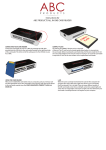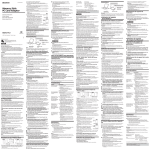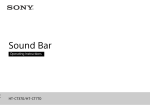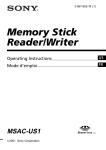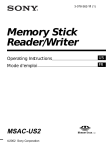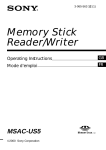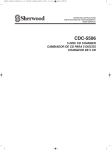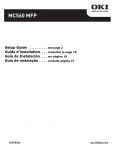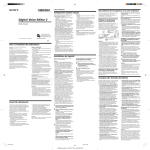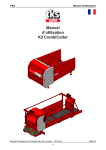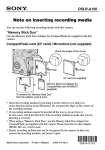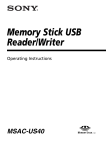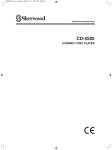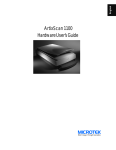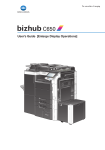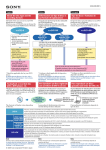Download Sony MSAC-PC3 User's Manual
Transcript
3-078-326-12 (1)
Memory Stick
PC Card Adaptor
Operating Instructions
US
Mode d’emploi
FR
MSAC-PC3
2002 Sony Corporation
1-US
English
Before operating the unit, please read this instructions thoroughly,
and retain it for future reference.
For the customers in U.S.A.
THIS DEVICE COMPLIES WITH PART 15 OF THE FCC RULES.
OPERATION IS SUBJECT TO THE FOLLOWING TWO
CONDITIONS:
(1) THIS DEVICE MAY NOT CAUSE HARMFUL INTERFERENCE,
AND
(2) THIS DEVICE MUST ACCEPT ANY INTERFERENCE RECEIVED,
INCLUDING INTERFERENCE THAT MAY CAUSE UNDESIRED
OPERATION.
CAUTION
You are cautioned that any changes or modifications not expressly
approved in this manual could void your authority to operate this
equipment.
Note:
This equipment has been tested and found to comply with the limits
for a Class B digital device, pursuant to Part 15 of the FCC Rules.
These limits are designed to provide reasonable protection against
harmful interference in a residential installation. This equipment
generates, uses, and can radiate radio frequency energy and, if not
installed and used in accordance with the instructions, may cause
harmful interference to radio communications. However, there is no
guarantee that interference will not occur in a particular installation. If
this equipment does cause harmful interference to radio or television
reception, which can be determined by turning the equipment off and
on, the user is encouraged to try to correct the interference by one or
more of the following measures:
– Reorient or relocate the receiving antenna.
– Increase the separation between the equipment and receiver.
– Connect the equipment into an outlet on a circuit different from that
to which the receiver is connected.
– Consult the dealer or an experienced radio/TV technician for help.
For the customers in Canada
This Class B digital apparatus complies with Canadian ICES-003.
2-US
Documentation©2002 Sony Corporation
• “Memory Stick”, “MagicGate Memory Stick”, “Memory Stick PRO”, “Memory
are trademarks of Sony Corporation.
Stick Duo”, “MagicGate”, and
• Microsoft, and Windows are registered trademarks of Microsoft Corporation
in the United States and/or other countries.
• Macintosh and MacOS are registered trademarks of Apple Computer, Inc. in
the United States and/or other countries.
• All other company names and product names mentioned here may be the
trademarks or registered trademarks of their respective companies.
The symbols for ™ and ® are omitted in these instructions.
3-US
Table of contents
Before You Begin
On “Memory Stick” .............................................................................................. 5
Required system construction ............................................................................ 7
Checking the supplied accessories ..................................................................... 8
Parts identification ............................................................................................... 8
How to Use (When Using Windows)
Connecting this unit to your computer ............................................................. 9
Confirming that connections are completed .................................................. 12
When the Removable Disk is not displayed ................................................... 17
Copying image data recorded on “Memory Stick” to your computer ....... 21
Disconnecting this unit from your computer ................................................. 22
How to Use (When Using Macintosh)
Connectiong this unit to your computer ......................................................... 24
Disconnecting this unit from your computer ................................................. 24
Other Information
Formatting (initialization) of “Memory Stick” ............................................... 25
Precautions for use of “Memory Stick” ........................................................... 26
Precautions for use of “Memory Stick Duo” .................................................. 28
Troubleshooting .................................................................................................. 29
Specifications ....................................................................................................... 31
LIMITED WARRANTY ..................................................................................... 32
4-US
BBefore You Begin
On “Memory Stick”
“Memory Stick” is a new-generation IC storage media that is ultra-small
and lightweight and has far greater storage capacity than floppy disks. It
can be used not only for transferring data between “Memory Stick”
compatible products, but also as a removable, external storage media for
storing data.
“Memory Stick” is available in standard size and a smaller size called
“Memory Stick Duo.” When “Memory Stick Duo” is inserted into a
Memory Stick Duo Adaptor, the size becomes the same as the standardsized “Memory Stick” to allow use with products that are compatible with
the standard-sized “Memory Stick.”
“Memory Stick” types that can be used with
this unit
Three types of “Memory Stick” are available to suit your needs.
“Memory Stick PRO”
This type of "Memory Stick" can only be used with products that are
compatible with "Memory Stick PRO," and the media features built-in
copyright-protection technology ("MagicGate"). (MSAC-PC3 is not
compatible with "MagicGate", however, you can use "Memory Stick PRO"
just like a "Memory Stick" to record of all kinds of data with the exception
of data requiring copyright-protection technology.)
“Memory Stick”
A “Memory Stick” that allows recording of all kinds of data with the
exception of data requiring copyright-protection technology
(“MagicGate”).
"MagicGate Memory Stick"
This is a “Memory Stick” featuring built-in copyright protection
technology (“MagicGate”). (MSAC-PC3 is not compatible with
“MagicGate”, however, you can use this unit just like a “Memory Stick” to
record of all kinds of data with the exception of data requiring copyrightprotection technology.)
5-US
Before You Begin
What is “Memory Stick”?
On “Memory Stick” (continued)
What is “MagicGate”?
“MagicGate” is a copyright protection technology that operates when it is
provided in both the “Memory Stick” and the product in which the media
is used. A “Do you comply with “MagicGate”?” authentication takes place
between devices equipped with “MagicGate”, and the “Memory Stick.”
Data encryption takes places after the authentication. This unit is not
equipped with “MagicGate”, so it can not record or playback the data
which needs “MagicGate”.
6-US
Required system construction
Recommended Windows environment
Recommended Macintosh environment
OS: Mac OS 8.5~9.2.2/X (v10.1.2~10.2.2)
* The operating systems mentioned above must be installed on the
computer when shipped from the factory.
* Operation is not guaranteed for upgraded operating systems even if they
are among those mentioned above.
PC Card Slot which is compatible with PC Card Type II as standard
equipment.
PNote
Operation is not guaranteed for all computers even if they comply with the
recommended environments.
7-US
Before You Begin
OS: Microsoft Windows 98/Windows 98Second Edition (Windows 98SE)/
Windows Millennium Edition (Windows Me)/Windows 2000 Professional
(Windows 2000)/Windows XP Home Edition/XP Professional (Windows
XP)
Microsoft Windows CE/1.0/2.0/2.11/3.0
* The operating systems mentioned above must be installed on the
computer when shipped from the factory.
* Operation is not guaranteed for upgraded operating systems even if they
are among those mentioned above.
PC Card Slot which is compatible with PC Card Type II as standard
equipment.
Checking the supplied accessories
• Memory Stick PC Card Adaptor (1)
• Specified Storage Case (1)
• Operating Instructions (1)
Parts identification
Serial number (An 8-digit
number printed on the
frame)
The Memory Stick
eject button
Access lamp
The slot based on
PC Card Type II
The Memory Stick
socket
PNote
The access lamp lights while the “Memory Stick” is being accessed. Never
remove the “Memory Stick,” turn off the computer, or remove the PC card
adaptor, while the access lamp is on. The data on the “Memory Stick” might be
destroyed.
8-US
BHow to Use (When using Windows)
Connecting this unit to your computer
1
2
Turn on your computer, and start up Windows.
Insert the PC Card Adaptor with a “Memory Stick” attached to
your computer firmly.
Recommended ways for connecting
When installing the PC Card Adaptor with “Memory Stick” attached into
the PC Card Slot on your computer
PNote
• Make sure that the “Memory Stick” is positioned correctly when inserting.
• The place of the PC card slot on the computer differ with the computers.
• Not all operations are guaranteed on all computers running under the
recommended environment.
3
Open the additional hardware wizard and begin driver
installation.
Depending on your operating system, driver installation may start
automatically, or the wizard may not start up.
Follow the instructions on the screen and click on the [Next] button to
carry out driver installation.
9-US
How to Use (When using Windows)
The operation of this unit has been confirmed when connected to the
computer in either of the following ways.
Connecting this unit to your computer (Continued)
4
5
6
Select “Search for the best driver for your device
[Recommended]” and click on [Next].
Do not check anything. Click on [Next].
Select “The updated driver [Recommended] Standard IDE/ESDI
Hard Disk Controller”.
10-US
7
How to Use (When using Windows)
8
Follow the instructions on the screen and click on [Next].
Click on the [Finish] button. Driver installation is now
complete.
You can now use the unit.
PNote
Start up the additional hardware wizard when you first use this unit, and when
you first use a “Memory Stick” with a different capacity.
11-US
Confirming that connections are
completed
1
Open the “My Computer” folder.
1 Double-click “My Computer”.
2 The “My Computer” folders appear.
2
Confirm that the newly recognized “Sony MemoryStick (F:)”
icon is shown.
This “Sony MemoryStick (F:)” icon indicates this unit connected to the
computer. Depending on the computer used, the drive letter (F:) may
be different.
The connection is completed when the “Sony MemoryStick (F:)” icon
is shown.
It may take a little while before the “Sony MemoryStick (F:)” icon
appears.
PNote
• If the “Sony MemoryStick (F:)” icon is not shown, the Device driver may not
be installed correctly. Perform the procedures described on page 17.
• “Sony MemoryStick (F:)” may be displayed as “Removable Disk (F:)” and
icons may differ depending on the type of OS and the “Memory Stick” you are
using.
• When using another “Removable Disk,” plural “Removable Disk” icons
appears.
• The “Memory Stick” may be recognized as “Local Disk (F:)” depending on the
“Memory Stick” you are using, though this will cause no problems in terms of
use. When using Windows 98/Windows 98SE/Windows Me, please refer to
“When Using Windows 98/Windows 98SE/Windows Me” described on the
next page and change disk settings from “Local Disk” to “Removable Disk”.
This will cause no problems in terms of use, but settings cannot be changed to
“Removable Disk” when the “Memory Stick” is recognized as a “Local Disk”
in Windows 2000/Windows XP. In this case, unlocking the LOCK switch
when using the “Memory Stick” is recommended (Page 26).
12-US
MSAC-PC3 3-078-326-12(1).US/FR
– When Using Windows 98/Windows 98SE/Windows Me –
When first using the unit, it will appear in the “My Computer” folder as a
“Local Disk” and not as a “Removable Disk”. There are no problems in
terms of use when it is used like this, though a blue screen may appear
when it is used with the LOCK switch in the locked position and a
warning may appear. In this event, use of the “Memory Stick” with the
disk drive settings changed from “Local Disk” to “Removable Disk” as
shown below is recommended.
1
3
4
5
After installation is complete, write down the drive letter
assigned to the “Memory Stick”. You can check the drive
letter by opening “My Computer” from the desktop.
Open the “Control Panel” from the [Settings] in the [Start]
menu.
Double-click [System].
Select the [Device Manager] tab from “System Properties” and
double-click [Disk drives].
13-US
MSAC-PC3 3-078-326-12(1).US/FR
How to Use (When using Windows)
2
Insert the unit with the “Memory Stick” inserted into your
computer and install drivers (Page 9). When drivers are
already installed, insert the unit with the “Memory Stick”
inserted into your computer and perform operations
according to the following steps.
Confirming that connections are completed
(Continued)
6
Search for the drive assigned to the unit in [GENERIC IDE DISK
TYPE XX] (XX is a 2-digit number or a “=” sign and a singledigit number). Search for the drive in question as follows.
1 Select the first [GENERIC IDE DISK TYPE XX] (in this example,
[GENERIC IDE DISK TYPE 00]), and click [Properties].
2 After opening the “Properties” window, click the [Settings] tab.
3 Check the text box for the “Current drive letter assignment”, if the
drive letter assigned to the unit is the same, then the selected
device drive is the drive assigned to the unit. If the drive letters are
different, click [Cancel], close the properties screen, select the next
[GENERIC IDE DISK TYPE XX] (in this example, [GENERIC IDE
DISK TYPE 40]), and check it by following the same steps.
4 Keep repeating these steps until you find the drive assigned to the
unit.
14-US
MSAC-PC3 3-078-326-12(1).US/FR
7
After you have checked the drive assigned to the unit, check
“Removable” in the settings screen and remove the check
from “Int 13 unit”.
be displayed, so click [Yes] and restart your computer.
15-US
MSAC-PC3 3-078-326-12(1).US/FR
How to Use (When using Windows)
8 Click [OK] and close the properties screen.
9 Click [OK] and close the system properties screen.
10 The following message for you to restart your computer will
Confirming that connections are completed
(Continued)
11 After restarting your computer, open “My Computer” and
check to see if the drive assigned to the unit has been
changed to “Removable Disk (X:)” (X is the drive letter
assigned to the unit). If the drive has not been changed,
settings are not reflected, so change settings again starting
at step 3 above.
PNote
• The drive assigned to the unit and the drive number (the XX portion in
[GENERIC IDE DISK TYPE XX]) may differ when you restart your computer.
• When first using a “Memory Stick” of a different capacity with this unit,
settings must be changed in the same manner after driver installation is
complete.
16-US
MSAC-PC3 3-078-326-12(1).US/FR
When the Removable Disk is not
indicated
A separate Device driver may already have been installed. Connect this
unit to your computer, insert a “Memory Stick” into the unit and then
perform the following procedure.
– When using Windows 2000/Windows XP –
Display the “System Properties” screen.
How to Use (When using Windows)
1
Double-click the “System” icon in the “Control Panel.”
The “System Properties” screen appears.
17-US
MSAC-PC3 3-078-326-12(1).US/FR
When the Removable Disk is not indicated
(Continued)
2
Check if the Device driver has already been installed.
1 Click the [Hardware] tab on
the “System Properties”
screen.
2 Click [Device Manager].
The “Device Manager”
screen appears.
3 Click [View].
4 Click [Devices by type]
5 Check whether [! SONYMemory Stick] preceded by
the “!” symbol is shown.
18-US
MSAC-PC3 3-078-326-12(1).US/FR
3
Delete the driver if installed.
If you use the procedure described in Step 2 and confirm that [! SONYMemory Stick] is shown under in the “Devices by type” display, a
separate device driver has already been installed.
Use the following procedure to delete this driver.
Do not delete other devices than [! SONY-Memory Stick].
Install the Device driver again by performing the procedure from
“Connecting this unit to your computer” described on page 9.
PNote
• If you delete other devices than [! SONY-Memory Stick] your computer
may no longer operate normally.
• The computer recognize the “Memory Stick” with different capacity as
the different divece.
• [! Sony-Memory Stick] may be displayed as the following depending on
the type of OS and the “Memory Stick” you are using.
[!Sony Memory Stick]
[!Standard IDE/ESDI Hard Disk Controller]
[!PCMCIA IDE/ATAPI Controller]
19-US
MSAC-PC3 3-078-326-12(1).US/FR
How to Use (When using Windows)
1 Right-click on [! SONY-Memory Stick].
2 Click on [Remove]. The “Confirm Device Removal” screen
appears.
3 Click the [OK] button. The device is removed.
4 Restart your computer after disconnecting this unit from the
computer.
When the Removable Disk is not indicated
(Continued)
– When using Windows 98/Windows 98SE/Windows Me –
1
Display the “System Properties” screen.
Double-click the “System” icon in the “Control Panel.”
2
Check if the Device driver has already been installed.
1 Click the [Device Manager] tab on the “System Properties” screen.
2 Check whether [! SONY-Memory Stick] preceded by the “!” symbol
is shown.
PNote
[! Sony-Memory Stick] may be displayed as the following depending on the
type of OS and the “Memory Stick” you are using.
[!Sony Memory Stick]
[!Standard IDE/ESDI Hard Disk Controller]
[!PCMCIA IDE/ATAPI Controller]
3
Delete the driver if installed.
If you use the procedure described in Step 2 and find that [! SonyMemory Stick] is shown, a separate device driver has already been
installed.
Use the following procedure to delete this driver.
Do not delete other devices than [! Sony-Memory Stick].
1 Click on [! Sony-Memory Stick].
2 Click on [Remove]. The “Confirm Device Removal” screen appears.
3 Click the [OK] button. The device is removed.
4 Close the “System Properties” screen.
5 Restart your computer after disconnecting this unit from the
computer.
Install the Device driver again by performing the procedure from
“Connecting this unit to your computer” described on page 9.
PNote
• If you delete other devices than [! Sony-Memory Stick] your computer
may no longer operate normally.
• The computer recognize the “Memory Stick”with different capacity as the
different device.
20-US
MSAC-PC3 3-078-326-12(1).US/FR
Copying image data recorded on
“Memory Stick” to your computer
If you remove this unit from your computer, the computer will no longer
be able to recognize this unit and the image data stored on the “Memory
Stick” can no longer be viewed on the computer. If you copy the image
data stored on the “Memory Stick” to your computer, the image data can
be displayed and processed on your computer even if this unit is not
connected to your computer.
PNote
For details on how to disconnect this unit from your computer, refer to
“Disconnecting this unit from your computer” described on page 22. Sony does
not accept liability for damage to this unit and the “Memory Stick”, or damage
of the data.
21-US
MSAC-PC3 3-078-326-12(1).US/FR
How to Use (When using Windows)
For details on how to copy image data to the computer, refer to the
operating instructions of your computer.
Disconnecting this unit from your
computer
After copying of the image data is completed, perform the procedure
described below before removing the “Memory Stick” from this unit and
removing this unit from the computer.
The screens shown in Windows XP are used in the following explanations.
The screens may differ slightly with the type of OS used.
1
Click the “Unplug or Eject Hardware” icon in the task tray in
the lower right corner of the screen.
Click this icon.
A message
appears.
This section is the task tray.
2
Click “Safely remove Sony Memory Stick-Drive (F:)”.
Click this section.
A message appears after
a little while.
* The drive letter “(F:), etc.” differs with the computer used.
PNote
The drive letter may be displayed as one of the following depending on the
OS and “Memory Stick” you are using.
[Sony-Memory Stick Drive (F:)]
[Standard IDE/ESDI Hard Disk Controller Drive (F:)]
[PCMCIA IDE/ATAPI Controller (F:)]
22-US
MSAC-PC3 3-078-326-12(1).US/FR
3
“Sony Memory Stick can be removed safely” will be displayed.
At this point, data is safe even if the unit is unplugged from the
computer.
*The display may differ depending on the OS you are using.
4
Remove this unit from the computer by pressing the eject
button on the PC Card Slot.
PNote
23-US
MSAC-PC3 3-078-326-12(1).US/FR
How to Use (When using Windows)
Do not remove the “Memory Stick” from the unit while the access lamp is
flashing or “Memory Stick” data may be corrupted.
BHow to Use (When using Macintosh)
Connecting this unit to your computer
and installing drivers
It can be used with OS standard device drivers.
Perform operations according to the following steps.
1
2
Turn on the power to your computer and start up the MacOS.
Firmly insert the unit with the “Memory Stick” attached until
it reaches the back of your computer’s PC card slot.
For connection of the unit to your computer, refer to page 9.
3
4
Driver installation will start automatically and drivers will be
installed on your computer.
When driver installation is complete, a Memory Stick icon will
be displayed on your desktop and you can use the unit.
Disconnecting this unit from your
computer
1
2
3
4
Close the software using this product.
Make sure that the unit’s access lamp is not lit.
Move the Memory Stick icon to the [Trash].
When the Memory Stick icon is selected, choose “Uninstall” in
the [Special] menu at the top left of the screen.
Remove the unit from your computer.
PNote
Do not remove the “Memory Stick” from the unit while the access lamp is
flashing or “Memory Stick” data may be corrupted.
24-US
MSAC-PC3 3-078-326-12(1).US/FR
BOther Information
Formatting (initialization) of “Memory
Stick”
This deletes all the data recorded on a “Memory Stick.” When formatting
on this unit, be sure to use the supplied “Memory Stick Formatter”
software program, following the procedures outlined below. Operation on
a Handycam or other “Memory Stick” compatible products is not
guaranteed for a “Memory Stick” formatted on a computer without the use
of the “Memory Stick Formatter” software program.
You can download the “Memory Stick Formatter” at the following Web
Site.
http://www.sony.net/memorystick/supporte
For the details on how to use the “Memory Stick Formatter”, refer to the
manual supplied with the “Memory Stick Formatter.”
PNote
1
2
3
Insert a “Memory Stick” into this unit, and install to your
computer.
Start “Memory Stick Formatter.”
After confirming that the drive is selected on which the
“Memory Stick” is recognized to have been mounted, click
[Start formatting]. Formatting begins.
PNote
Do not remove this unit from the computer while formatting the “Memory
Stick”. The data on the “Memory Stick” may be damaged.
25-US
MSAC-PC3 3-078-326-12(1).US/FR
Other Information
If you format a “Memory Stick” that contains recorded data, the already
recorded data will be deleted. Be careful not to inadvertently delete important
data.
Precautions for use of “Memory Stick”
LOCK (write-protect) switch
When the “Memory Stick” is used with the LOCK
switch in the locked position, a blue screen and
warning may appear. Unlocking the LOCK switch
when using the “Memory Stick” is recommended.
In addition, copying or writing to the “Memory Stick”, deleting data, or
formatting the “Memory Stick” with the LOCK switch in the locked
position may cause writing and other operations to appear as if they have
been performed when they have actually not been performed.
Do not write to the “Memory Stick” with the LOCK switch in the locked
position.
Data read/write speed
The data read/write speed differs with the “Memory Stick” media and
product combination that you are using.
Capacity of “Memory Stick PRO” that can be
used with this unit (when using Windows )
Any “Memory Stick PRO” with a capacity of up to 4GB can be used with
this unit. A “Memory Stick PRO” with a memory larger than 4GB will not
operate properly if inserted.
Only use a “Memory Stick PRO” with a capacity of 4GB or less.
There is no capacity limit when using a Macintosh computer.
26-US
MSAC-PC3 3-078-326-12(1).US/FR
how to affix
labels
A
B
27-US
MSAC-PC3 3-078-326-12(1).US/FR
Other Information
• Never remove the “Memory Stick” while the access lamp is on (while
data is being read/written).
• Data may be corrupted in the following cases.
– If the “Memory Stick” is removed or the power to this unit is turned
off while the access lamp is on (while data is being read/written)
– When used in a location subject to static electricity or electrical noise
• Always backup important data. Sony does not accept liability for it, even
if data is lost.
• We cannot accept responsibility in the event that data is lost or damaged
and the unit is damaged, while using this unit.
• Data copyright protected by “MagicGate” can only be used with a
“MagicGate Memory Stick.” (This unit is not compatible with
“MagicGate”.)
• Do not touch the connector section A with fingers or metallic objects.
• Do not affix any label other than those specially provided on the label
space B.
• When affixing labels, affix these at the designated positions. Labels
should not protrude from the edges of the “Memory Stick.”
• When transporting or storing a “Memory Stick,” place it in the supplied
storage case.
• Do not bend, drop or subject the “Memory Stick” to strong impacts.
• Do not attempt to disassemble or modify the “Memory Stick.”
• Do not wet with water.
• Avoid use and storage in the following locations.
– In a car where the temperature may become very high or in other hot
locations
– Location subject to direct sunlight
– Location with high humidity or where corrosive substances are
present.
Precautions for use of “Memory Stick
Duo”
• When using “Memory Stick Duo” with this unit, make sure the “Memory
Stick Duo” has been inserted into the Memory Stick Duo Adaptor before
starting to use.
• Confirm that the “Memory Stick” is positioned correctly before inserting
for use.
• Do not insert the Memory Stick Duo Adaptor into “Memory Stick”
compatible products when no “Memory Stick Duo” is inserted into the
Memory Stick Duo Adaptor.
If used in these ways, malfunctions may occur.
28-US
MSAC-PC3 3-078-326-12(1).US/FR
Troubleshooting
Symptom
The [Removable Disk]
icon is not displayed.
29-US
MSAC-PC3 3-078-326-12(1).US/FR
Other Information
Cause/Solution
•Not connected correctly.
t Connect correctly. (Page 9)
•The Device driver is not installed.
t Install the Device driver in the right
way. (Page 9)
•“Memory Stick” is not inserted.
t Insert a “Memory Stick.”
The access lamp blinks
•Foreign matter adhering to the
when a “Memory Stick” is connector section of the “Memory
inserted.
Stick.”
t Check whether dust or dirt is
adhering to the connector section of
the “Memory Stick.”
Remove any foreign matter and
insert the “Memory Stick” again.
Reading data on the
• The “Memory Stick” is write-protected.
“Memory Stick”, writing
t Unlock the LOCK switch (Page 26).
data to the “Memory
• The “Memory Stick” is set as a “Local
Stick”, and copying may
Disk” (When Using Windows 98/
cause a blue screen and
Windows 98SE/Windows Me).
warning to appear.
t Change the drive settings for the
“Memory Stick” to “Removable
Disk” (Page 13).
Writing data to or
• The ”Memory Stick” is write-protected.
deleting data from the
t Unlock the LOCK switch (Page 26).
“Memory Stick” may
t Do not write to the ”Memory Stick”
appear to be taking place,
with the LOCK switch in the locked
but the data on the
position.
“Memory Stick” has not
• The ”Memory Stick” is set as a “Local
been changed.
Disk” (When Using Windows 98/
Windows 98SE/Windows Me).
t Change the drive settings for the
”Memory Stick” to “Removable
Disk” (Page 13).
Troubleshooting (Continued)
Cause/Solution
Symptom
•The eject button is pushed into the PC
The “Memory Stick”
card.
cannot be ejected from the
t Hold the “Memory Stick” between
Memory Stick PC Card
your fingers and pull it out.
adaptor.
t The Memory Stick PC card adaptor is
not damaged.
You can continue to use it, after
removing the “Memory Stick”.
t It may happen if you insert the
“Memory Stick” in this unit while
pressing the panel part of this unit
strongly. Do not press it when you
insert the “Memory Stick” in.
30-US
MSAC-PC3 3-078-326-12(1).US/FR
Specifications
Memory Stick PC Card Adaptor
Interface: PCMCIA ATA 16bit (PC Card Type II)
Operating voltage
Power consumption
External dimensions
Mass
Operating conditions
DC 3.3 V/5.0 V
Max. 90 mA DC
Approx. 54 × 5.0 × 85.6 mm
(2 1/4 × 2 × 3 3/8 in.) (W × H × D)
Approx. 30 g (1.06 oz)(not including
“Memory Stick”)
Temperature 0°C to 60°C (32 °F to 140 °F)
(no condensation)
Humidity
20% to 80%
(no condensation)
Design and specifications are subject to change without notice.
Other Information
If you have any questions/comments related to this product,
please visit our Customer Support website at
http://www.sony.net/memorystick/supporte
31-US
MSAC-PC3 3-078-326-12(1).US/FR
LIMITED WARRANTY
If this product should prove defective in workmanship or material
during the period of 1 year from the date of original purchase at retail,
the same will be replaced by either the Seller, or Sony Electronics,
Inc. or Sony of Canada, Ltd.
SUCH REPLACEMENT SHALL BE THE SOLE REMEDY OF THE
CONSUMER, AND THERE SHALL BE NO LIABILITY ON THE PART
OF THE MANUFACTURER, DISTRIBUTOR OR SELLER FOR ANY
LOSS OR DAMAGE, DIRECT OR CONSEQUENTIAL, ARISING OUT
OR THE USE OF, OR INABILITY TO USE, THIS PRODUCT.
Some states of the United States do not allow the exclusion of
incidental or consequential damages, so the above exclusion may not
apply to you.
This warranty gives you specific legal rights and you may also have
other rights which vary from state to state in the United States, Puerto
Rico or from province to province in Canada.
In the United States, contact: Sony Electronics Inc.,
Sony Building, 680 Kinderkamack Road, Oradell, New Jersey 07649.
In Canada, contact: Sony of Canada Ltd.,
115 Gordon Baker Road, Toronto, Ontario, M2H 3R6 CANADA.
32-US
MSAC-PC3 3-078-326-12(1).US/FR
33-US
MSAC-PC3 3-078-326-12(1).US/FR
Français
Avant d’utiliser cet appareil, veuillez lire attentivement ces explications,
puis conservez-les de manière à pouvoir les consulter.
Pour les clients au Canada
Cet appareil numérique de la classe B est conforme à la norme NMB-003
du Canada.
Documentation©2002 Sony Corporation
• “Memory Stick”, “MagicGate Memory Stick”, “Memory Stick PRO”, “Memory
Stick Duo”, “MagicGate” et
sont des marques de fabrique de Sony
Corporation.
• Microsoft et Windows sont des marques déposées de Microsoft Corporation
aux États-Unis et/ou dans d’autres pays.
• Macintosh et Mac OS sont des marques déposées de Apple Computer Inc., aux
États-Unis et/ou dans d’autres pays.
• Tous les autres noms de compangies et noms de produits, mentionnés dans
cette brochure, peuvent être des marques de fabrique ou des marques
déposées de leurs détenteurs respectifs.
Les symboles ™ et ® sont supprimés dans la présente brochure.
2-FR
MSAC-PC3 3-078-326-12(1).US/FR
Table des matières
Informations préliminaires
A propos des “Memory Stick” ............................................................................ 4
Éléments requis pour la construction du système ........................................... 6
Vérification des accessoires fournis ................................................................... 7
Nomenclature ........................................................................................................ 7
Utilisation de l’appareil (avec Windows)
Brannchement de l'appareil à l’ordinateur ....................................................... 8
Vérification des connexions .............................................................................. 11
Si l’icône du disque amovible n’apparaît pas ................................................. 16
Copie sur l’ordinateur de photos enregistrées sur le “Memory Stick” ...... 20
Débranchement de l'appareil de l'ordinateur ................................................. 21
Utilisation de l’appareil (À l’emploi d’un Macintosh)
Brannchement de l’appareil sur l’ordinateur et installation des
gestionnaires ....................................................................................................... 23
Débranchement de cet appareil et de votre ordinateur ................................ 24
Informations diverses
Formatage (initialisation) d’un “Memory Stick” ........................................... 25
Remarques sur l’emploi des “Memory Stick” ................................................ 26
Précautions convernant l’emploi des “Memory Stick Duo” ........................ 28
En cas de problème ............................................................................................ 29
Spécifications ....................................................................................................... 31
GARANTIE RESTREINE ................................................................................... 32
3-FR
MSAC-PC3 3-078-326-12(1).US/FR
BInformations préliminaires
A propos des “Memory Stick”
Qu’est-ce qu’un “Memory Stick” ?
Le “Memory Stick” est un nouveau support d’enregistrement à circuit
intégré, minuscule et léger, dotée d’une capacité de stockage bien
supérieure à celle des disquettes. Ce support peut être utilisé non
seulement pour l’échange de données entre divers produits compatibles
avec les “Memory Stick”, mais aussi comme support de stockage,
amovible.
Les “Memory Stick” existent en deux tailles, les “Memory Stick” de taille
standard et les “Memory Stick Duo” de plus petite taille. Les “Memory
Stick Duo” peuvent être insérés dans un adaptateur de Memory Stick Duo
et utilisés sur les appareils compatibles avec les “Memory Stick” standard.
Types de “Memory Stick” pouvant être utilisés
avec cet appareil
Trois types de “Memory Stick” sont disponibles pour convenir à vos
besoins particuliers.
“Memory Stick PRO”
Ce type de “Memory Stick” ne peut être utilisé qu’avec les produits
compatibles avec les “Memory Stick PRO” et intègre une technologie
antipiratage (“MagicGate”). (MSAC-PC3 n’est pas compatible avec la
technologie “MagicGate” mais les “Memory Stick PRO” peuvent être
utilisés comme les “Memory Stick” pour l’enregistrement de divers types
de données dans la mesure où elles ne sont pas protégées par une
technologie antipiratage.)
“Memory Stick”
Ce type de “Memory Stick” permet d’enregistrer toutes sortes de données
à l’exception de données exigeant la technologie de protection des droits
d’auteur “MagicGate”.
“MagicGate Memory Stick”
Ce type de “Memory Stick” intègre la technologie de protection des droits
d’auteur “MagicGate”. (L’adaptateur MSAC-PC3 n’est pas compatible
avec “MagicGate”, mais vous pouvez utiliser le cet appareil exactement
comme un “Memory Stick” pour l’enregistrement de toutes sortes de
données, à l’exception de celles qui font appel à la technologie de
protection des copyrights.)
4-FR
MSAC-PC3 3-078-326-12(1).US/FR
Qu’est-ce que “MagicGate” ?
5-FR
MSAC-PC3 3-078-326-12(1).US/FR
Informations préliminaires
“MagicGate” est une technologie de protection des droits d’auteur qui
fonctionne avec les “Memory Stick” et les produits compatibles avec les
“Memory Stick” et dotés de ce système.
Le message “Y a-t-il compatibilité avec “MagicGate” ? ” sert à authentifier
les appareils dotés du système “MagicGate” et le “Memory Stick”. Comme
cet appareil ne comporte pas “MagicGate” et il ne permet donc pas
d’enregistrer et de lire des données, nécessitant “MagicGate”.
Éléments requis pour la construction du
système
Environnement Windows recommandé
Système d'exploitation : Microsoft Windows 98/Windows 98 Second
Edition (Windows 98SE)/Windows Millennium Edition (Windows Me)/
Windows 2000 Professional (Windows 2000)/Windows XP Home Edition/
XP Professional (Windows XP)
Microsoft Windows CE/1.0/2.0/2.11/3.0
* Les systèmes d’exploitation mentionnés ci-dessus doivent être installés
en usine sur l'ordinateur.
* Le fonctionnement n’est pas garanti pour les mises à jour avec les
systèmes mentionnés ci-dessus.
Fente de Carte PC compatible avec une Carte PC de Type II comme
équipement standard.
Environnement Macintosh recommandé
Système d'exploitation : Mac OS 8.5~9.2.2/X (v10.1.2~10.2.2)
* Les systèmes d’exploitation mentionnés ci-dessus doivent être installés
en usine sur l'ordinateur.
* Le fonctionnement n’est pas garanti pour les mises à jour avec les
systèmes mentionnés ci-dessus.
Fente de Carte PC compatible avec une Carte PC de Type II comme
équipement standard.
PRemarque
Le fonctionnement ne peut pas être garanti pour tous les ordinateurs conformes
à l’environnement recommandé.
6-FR
MSAC-PC3 3-078-326-12(1).US/FR
Vérification des accessoires fournis
• Adaptateur de carte PC Memory Stick (1)
Informations préliminaires
• Étui rangement spécifié (1)
• Mode d'emploi de l'appareil (1)
Nomenclature
Numéro de série (Un
numéro de 8 chiffres,
imporimé sur le cadre)
Bouton d’éjection
de Memory Stick
Voyant d’accès
Fente basée sur
Carte PC de Type II
Prise Memory Stick
PRemarque
Le voyant d’accès s’allume pendant l’accès à la carte “Memory Stick”. Pendant
que ce voyant est allumé, ne retirez jamais le “Memory Stick”, ne mettez jamais
l’ordinateur hors tension et ne retirez jamais l’adaptateur de carte PC, car les
données présentes sur le “Memory Stick” pourraient en être endommagées.
7-FR
MSAC-PC3 3-078-326-12(1).US/FR
BUtilisation de l’appareil (avec Windows)
Brannchement de l'appareil à
l’ordinateur
1
2
Mettez votre ordinateur sous tension et lancez Windows.
Dans votre ordinateur, insérez fermement l’adaptateur de
carte PC, portant un “Memory Stick”.
Méthodes de connexion recommandés
Le fonctionnement de cet appareil a été confirmé lors d’un branchement à
l’ordinateur par une des méthodes Nextes.
Lors de l’installation de l’Adaptateur de Carte PC, portant un “Memory
Stick”, dans la fente pour Carte PC de votre ordinateur
PRemarque
• Avant son insertion, assurez-vous que le “Memory Stick” est correctement
positionnee.
• L’emplacement de la fente pour Carte PC varie selon les ordinateurs.
• Toutes les opérations ne sont pas garanties sur tous les ordinateurs, même
utilisés dans l’environnement recommandé.
3
Ouvrez l’assistant supplémentaire et lancez l’installation du
logiciel de pilotage.
Selon le système d’exploitation, il se peut que l’installation du logiciel
de pilotage commence automatiquement ou que l’assistant ne soit pas
lancé.
Suivez les explications apparaissant sur l’écran et cliquez sur le bouton
[Next] pour effectuer l’installation du pilote.
8-FR
MSAC-PC3 3-078-326-12(1).US/FR
4
6
Utilisation de l’appareil (avec Windows)
5
Sélectionnez “Search for the best driver for your device
[Recommended]” et cliquez sur [Next].
Ne cochez rien. Cliquez sur [Next].
Sélectionnez “The updated driver [Recommended] Standard
IDE/ESDI Hard Disk Controller”.
9-FR
MSAC-PC3 3-078-326-12(1).US/FR
Brannchement de l'appareil à l’ordinateur (suite)
7
8
Suivez les explications apparaissant sur l’écran et cliquez sur
le bouton [Next].
Cliquez sur le bouton [Finish]. L’installation du logiciel de
pilotage est ainsi terminée.
Désormais, vous pouvez utiliser l’appareil.
PRemarque
Lancez l’assistant de matériel supplémentaire lors de la première utilisation de
l’appareil et quand vous utilisez pour la première fois un “Memory Stick” d’une
capacité différente.
10-FR
MSAC-PC3 3-078-326-12(1).US/FR
Vérification des connexions
1
Ouvrez le dossier “My Computer”.
1 Double-cliquez sur “My Computer”.
2 Les dossiers figurant dans le poste de travail apparaissent.
2
Assurez-vous que l'icône du “Sony MemoryStick (F:)” apparaît.
PRemarque
• Si l’icône “Sony MemoryStick (F:)” n’apparaît pas, il se peut que le
gestionnaire de périphérique ne soit pas correctement installé. Dans ce cas,
effectuez les démarches, décrites à la page 16.
• Le message “Sony MemoryStick (F:)” peut être affiché comme “Removable
Disk (F:)” et les icones peuvent différer selon le type de système d’exploitation
et de “Memory Stick” utilisé.
• Si vous utilisez un autre “Removable Disk”, il se peut que plusieurs icônes
“Removable Disk” apparaissent.
• Selon le “Memory Stick” utilisé, il se peut que le “Memory Stick” soit identifié
comme “Local Disk (F:)”, mais ceci ne sera pas cause de problèmes à l’emploi.
Si vous utilisez Windows 98/Windows 98SE/Windows Me, reportez-vous à
“A l’emploi de Windows 98/Windows 98SE/Windows Me” à la page
suivante et changez le réglage de disquette de “Local Disk” à “Removable
Disk”.
Vous ne rencontrerez pas de problèmes d’utilisation, mais les réglages ne
peuvent pas être changés à “Removable Disk” lorsque le “Memory Stick” est
identifié comme un “Local Disk” sous Windows 2000/Windows XP. Dans ce
cas, il est conseillé de débloquer le commutateur LOCK lorsque vous utilisez
le “Memory Stick” (page 26).
11-FR
MSAC-PC3 3-078-326-12(1).US/FR
Utilisation de l’appareil (avec Windows)
L'icône du “Sony MemoryStick (F:)” indique que l'appareil est
raccordé à l'ordinateur. La désignation du lecteur (F:) peut être
différente sur certains ordinateurs.
La connexion est terminée lorsque l'icône du “Sony MemoryStick (F:)”
apparaît.
Il faut attendre un instant pour que l'icône apparaisse.
Vérification des connexions (suite)
– A l’emploi de Windows 98/Windows 98SE/Windows Me –
Lors de la première utilisation de l’appareil, il apparaît dans le dossier “My
Computer” comme un “Local Disk” et non comme un “Removable Disk”.
Vous n’éprouverez pas de difficultés lorsqu’il est utilisé ainsi, mais un
écran bleu peut apparaître lorsqu’il est utilisé alors que le commutateur
LOCK se trouve à la position “verrouillé” et un message avertisseur risque
d’apparaître. Dans ce cas, l’emploi du “Memory Stick” après avoir changé
les réglages du lecteur de “Local Disk” à “Removable Disk” est
recommandé. Procédez comme suit pour ce changement.
1
2
3
4
5
Insérez dans votre ordinateur l’unité où est installé le
“Memory Stick” et installez les logiciels de pilotage (page 8).
Si ces logiciels de pilotage sont déjà installés, insérez dans
votre ordinateur l’unité où est installé le “Memory Stick” et
effectuez les opérations Nextes.
Une fois que l’installation est achevée, inscrivez la lettre du
lecteur, affectée au “Memory Stick”. Vous pouvez vérifier
cette lettre en ouvrant “My Computer” sur votre ordinateur.
Ouvrez le “Control Panel” sous [Settings] dans le menu [Start].
Double-cliquez sur [System].
Sélectionnez l’onglet [Device Manager] sous “System
Properties” et double-cliquez sur [Disk drives].
12-FR
MSAC-PC3 3-078-326-12(1).US/FR
6
Recherchez le lecteur affecté à l’unité sous [GENERIC IDE DISK
TYPE XX] (XX étant un nombre de 2 chiffres ou un signe “=” et
un nombre d’un chiffre). Recherchez comme suit le lecteur en
question.
1 Sélectionnez le premier [GENERIC IDE DISK TYPE XX] (dans cet
exemple : [GENERIC IDE DISK TYPE 00]) et cliquez sur
[Properties].
2 Après ouverture de la fenêtre “Properties”, cliquez sur l’onglet des
[Settings].
13-FR
MSAC-PC3 3-078-326-12(1).US/FR
Utilisation de l’appareil (avec Windows)
3 Vérifiez dans la boîte de texte “Current drive letter assignment”. Si
la lettre de lecteur affectée à l’unité est la même, le lecteur de
périphérique sélectionné sera le lecteur affecté à l’unité. Si les
lettres des lecteurs sont différentes, cliquez sur [Cancel], renfermez
l’écran des propriétés, sélectionnez le [GENERIC IDE DISK TYPE
XX] Next (dans cet exemple [GENERIC IDE DISK TYPE 40]) et
vérifiez en effectuant les mêmes démarches.
4 Répétez ces démarches jusqu’à ce que vous trouviez le lecteur
affecté à l’unité.
Vérification des connexions (suite)
7
8
9
Après avoir coché le lecteur affecté à l’unité. cochez
“Removable” sur l’écran de réglage et décochez “Int 13 unit”.
Cliquez sur [OK] et refermez l’écran des propriétés.
Cliques sur [OK] et refermez l’écran des propriétés du
système.
10 Un message vous invitant à remettre votre ordinateur en
marche est affiché; cliquez sur [Yes] et relancez votre
ordinateur.
14-FR
MSAC-PC3 3-078-326-12(1).US/FR
11 Après avoir relancé votre ordinateur, ouvrez “My Computer”
et vérifiez si le lecteur affecté à l’unité a été changé à
“Removable Disk (X:)” (X étant la lettre du lecteur affecté à
l’unité). Si le lecteur n’a pas été changé, les réglages ne sont
pas reflétés. Vous devez donc les changer en recommençant
à l’étape 3 ci-dessus.
15-FR
MSAC-PC3 3-078-326-12(1).US/FR
Utilisation de l’appareil (avec Windows)
PRemarque
• Le lecteur affecté à l’unité et le numéro de lecteur (la partie XX dans
[GENERIC IDE DISK TYPE XX]) peuvent être différents lors de la remise en
marche de votre ordinateur.
• Lors de l’utilisation d’un “Memory Stick” d’une capacité différente avec cette
unité, les réglages doivent être changés de la même façon après que
l’installation du logiciel de pilotage est terminée.
Si l’icône du disque amovible
n’apparaît pas
Il se peut qu’un autre gestionnaire de périphérique ait déjà été installé.
Dans ce cas, raccordez l'appareil à l'ordinateur, insérez un “Memory Stick”
dans l'appareil et effectuez les opérations Nextes.
– Lorsque vous utilisez Windows 2000/Windows XP –
1
Affichez l'écran “System Properties”.
Double-cliquez l’icone “System” dans le “Control Panel”.
L'écran “System Properties” apparaît.
16-FR
MSAC-PC3 3-078-326-12(1).US/FR
2
Vérifiez si un gestionnaire de périphérique est déjà installé.
1 Cliquez sur l’onglet
[Hardware] sur l'écran
“System Properties”.
L'écran “Device Manager”
apparaît.
3 Cliquez sur [View].
4 Cliquez sur [Devices by type].
5 Vérifiez si [! SONY-Memory
Stick] précédé du point
d’interrogation apparaît.
17-FR
MSAC-PC3 3-078-326-12(1).US/FR
Utilisation de l’appareil (avec Windows)
2 Cliquez sur [Device Manager].
Si l’icône du disque amovible n’apparaît pas
(suite)
3
Supprimez le pilote s’il est installé.
Si vous utilisez la procédure décrite à l’Étape 2 et que vous constatez
que [! SONY-Memory Stick] apparaît sous l’affichage “Devices by
type”, c’est qu’un gestionnaire de périphérique différent a déjà été
installé.
Procédez de la façon Nexte pour supprimer ce pilote.
Ne pas supprimer d’autres pilotes que [! SONY-Memory Stick].
1 Cliquez à droite sur [! SONY-Memory Stick].
2 Cliquez sur [Remove]. L’écran “Confirm Device Removal”
apparaît.
3 Cliquez sur le bouton [OK]. Le périphérique est supprimé.
4 Redémarrez l'ordinateur après avoir débranché l'appareil de
l'ordinateur.
IInstallez à nouveau le gestionnaire de périphérique en effectuant les
démarches sous “Brannchement de l’appareil à l’ordinateur”, que vous
trouverez à la page 8.
PRemarque
• Si vous supprimez d’autres périphériques que [! SONY-Memory Stick],
l'ordinateur risque de ne plus fonctionner correctement.
• L’ordinateur identifie un “Memory Stick” dont la capacité est différente
comme étant un périphérique différent.
• Le message [! Sony-Memory Stick] peut apparaître comme suit selon le
type de système d’exploitation et le “Memory Stick” que vous utilisez.
[! Sony Memory Stick]
[! Standard IDE/ESDI Hard Disk Controller]
[! PCMCIA IDE/ATAPI Controller]
18-FR
MSAC-PC3 3-078-326-12(1).US/FR
– Si vous utilisez Windows 98/Windows 98SE/Windows Me –
1
Affichez l'écran “System Properties”.
Double-cliquez l’icone “System” dans le “Control Panel”.
2
Vérifiez si un gestionnaire de périphérique est déjà installé.
1 Cliquez sur l’onglet [Device Manager] sur l'écran “System
Properties”.
2 Vérifiez si vous voyez [! SONY-Memory Stick] précédé du point
d’interrogation.
3
Supprimez le pilote s’il est installé.
Si vous utilisez la procédure décrite à l’Étape 2 et que vous constatez
que [! Sony-Memory Stick] apparaît, c’est qu’un gestionnaire de
périphérique différent a déjà été installé.
Procédez de la façon Nexte pour supprimer ce pilote.
Ne pas supprimer d’autres pilotes que le [! SONY-Memory Stick].
1 Cliquez sur [! Sony-Memory Stick].
2 Cliquez sur [Remove]. L'écran “Confirm Device Removal”
apparaît.
3 Cliquez sur le bouton [OK]. Le pilote est supprimé.
4 Fermez l'écran “System Properties”.
5 Redémarrez votre ordinateur après avoir débranché l'appareil de
l'ordinateur.
Installez à nouveau le gestionnaire de périphérique en effectuant les
démarches sous “Brannchement de l’appareil à l’ordinateur”, que vous
trouverez à la page 8.
PRemarque
• Si vous supprimez d’autres périphériques que [! Sony-Memory Stick],
votre ordinateur risque de ne plus fonctionner correctement.
• L’ordinateur identifie un “Memory Stick” dont la capacité est différente
comme étant un périphérique différent.
19-FR
MSAC-PC3 3-078-326-12(1).US/FR
Utilisation de l’appareil (avec Windows)
PRemarque
Le message [! Sony-Memory Stick] peut apparaître comme suit selon le type
de système d’exploitation et le “Memory Stick” que vous utilisez.
[! Sony Memory Stick]
[! Standard IDE/ESDI Hard Disk Controller]
[! PCMCIA IDE/ATAPI Controller]
Copie sur l’ordinateur de photos
enregistrées sur le “Memory Stick”
Si vous retirez cet appareil hors de votre ordinateur, celui-ci ne sera plus
capable de reconnaître cet appareil et les données d’image, mémorisées sur
le “Memory Stick” ne pourront plus être affichées sur l’ordinateur. Si vous
copiez les photos enregistrées sur le “Memory Stick” sur l'ordinateur, vous
pourrez les voir quand vous voudrez et éventuellement les retoucher, sans
avoir à raccorder l'appareil à l'ordinateur.
Pour des explications sur la façon de copier les données d’image sur
l’ordinateur, reportez-vous au mode d’emploi de votre ordinateur.
PRemarque
Pour des explications sur la façon de déconnecter cet appareil et votre
ordinateur, reportez-vous à “Débranchement de l’appareil l’ordinateur” à la
page 21. Sony décline toute responsabilité pour des dégâts subis par cet
appareil, le “Memory Stick” ou les données mémorisées.
20-FR
MSAC-PC3 3-078-326-12(1).US/FR
Débranchement de l'appareil de
l'ordinateur
A la fin de la copie des données d’image, effectuez les démarches décrites
ci-après avant de retirer le “Memory Stick” hors de l’appareil et de retirer
l’appareil hors de l’ordinateur.
1
Cliquez sur l'icône “Unplug or Eject Hardware” dans le plateau
de tâches dans le coin inférieur droit de l'écran.
Cliquez sur cette icône.
Un message
apparaît.
Le plateau de tâches est ici.
2
Cliquez sur “Safely remove Sony Memory Stick-Drive (F:)”.
Cliquez ici.
Un message apparaît un
instant plus tard.
* La désignation du lecteur “(F:), etc.” peut être différente sur certains
ordinateurs.
PRemarque
Selon le système d’exploitation et le “Memory Stick” utilisé, la lettre du
lecteur peut être affichée comme indiqué ci-après.
[Sony-MemoryStick Drive (F:)]
[Standard IDE/ESDI Hard Disk Controller Drive (F:)]
[PCMCIA IDE/ATAPI Controller (F:)]
21-FR
MSAC-PC3 3-078-326-12(1).US/FR
Utilisation de l’appareil (avec Windows)
Les écrans représentés ici sont ceux de Windows XP.
Selon le système d'exploitation utilisé, ils peuvent être légèrement
différents.
Débranchement de l'appareil de l'ordinateur
(suite)
3
Le message “Sony Memory Stick can be removed safely” est
affiché.
A ce stade, les données seront en sécurité, même si l’appareil est
débranché de l’ordinateur.
* Selon le système d’exploitation utilisé, il se peut que cet affichage soit
différent.
4
Retirez cet appareil hors de l’ordinateur en actionnant le
bouton d’éjection sur la fente de Carte PC.
PRemarque
Ne retirez pas le “Memory Stick” hors de l’appareil pendant que le voyant
d’accès clignote car les données qui y sont mémorisées seraient détruites.
22-FR
MSAC-PC3 3-078-326-12(1).US/FR
BUtilisation de l’appareil (À l’emploi d’un
Macintosh)
Brannchement de l’appareil sur
l’ordinateur et installation des
gestionnaires
Il peut être utilisé avec les gestionnaires de périphériques standards.
Effectuez les opérations selon les étapes Nextes.
1
2
Mettez votre ordinateur sous tension et lancez le système
MacOS.
Insérez fermement l’appareil dans lequel le “Memory Stick”
est installé jusqu’au fond de la fente de carte PC de votre
ordinateur.
3
4
L’installation du gestionnaire commence automatiquement et
les gestionnaires seront installés sur votre ordinateur.
Lorsque l’installation du gestionnaire est achevée, une icone
Memory Stick apparaît sur le bureau et vous pouvez utiliser
l’appareil.
23-FR
MSAC-PC3 3-078-326-12(1).US/FR
Utilisation de l’appareil (À l’emploi d’un Macintosh)
Pour le branchement de l’appareil sur votre ordinateur, reportez-vous
à la page 8.
Débranchement de cet appareil et de
votre ordinateur
1
2
3
4
Refermez le logiciel utilisant ce produit.
Assurez-vous que le voyant d’accès de l’appareil est éteint.
Déplacez l’icone Memory Stick dans la [Trash].
Lorsque l’icone Memory Stick est sélectionnée, choisissez
“Uninstall” sous le menu [Special] dans le coin supérieur
gauche de l’éran.
Retirez l’appareil hors de votre ordinateur.
PRemarque
Ne retirez pas le “Memory Stick” hors de l’appareil pendant que le voyant
d’accès clignote car les données qui y sont mémorisées seraient détruites.
24-FR
MSAC-PC3 3-078-326-12(1).US/FR
BInformations diverses
Formatage (initialisation) d’un
“Memory Stick”
Le formatage supprime toutes les données enregistrées sur le “Memory
Stick”. Pour formater un “Memory Stick” sur cet appareil, il faut utiliser le
programme fourni “Memory Stick Formatter” et effectuez les opérations
suivantes. Les “Memory Stick” formatés sur un ordinateur sans le
programme “Memory Stick Formatter” ne fonctionneront probablement
pas sur un Handycam ou un appareil compatible avec les “Memory Stick”.
Vous pouvez télécharger le “Memory Stick Formatter” en accédant au site
Web ci-dessous.
http://www.sony.net/memorystick/supporte
Pour des détails sur l’utilisation du “Memory Stick Formatter”, consultez
le manuel, fourni avec le logiciel “Memory Stick Formatter”.
PRemarque
Lorsque vous formatez un “Memory Stick”, toutes les données déjà enregistrées
sont effacées. Veillez à ne pas effacer des données importantes par inadvertance.
2
3
Insérez un “Memory Stick” dans cet appareil et installez-le
dans votre ordinateur.
Lancez “Memory Stick Formatter”.
Après avoir vérifié que le lecteur contenant le “Memory Stick”
était bien sélectionné, cliquez sur [Start formatting]. Le
formatage commence.
PRemarque
Ne retirez pas cet appareil hors de l’ordinateur pendant le formatage du
“Memory Stick”, car les données présentes sur le “Memory Stick” pourraient en
être endommagées.
25-FR
MSAC-PC3 3-078-326-12(1).US/FR
Informations diverses
1
Remarques sur l’emploi des “Memory
Stick”
Interrupteur LOCK (protection
contre écriture)
Lorsque le “Memory Stick” est utilisé alors que le
commutateur LOCK est à la position verrouillée, un
écran bleu et un avertissement peuvent apparaître. Il
est conseillé de débloquer le commutateur LOCK à
l’emploi du “Memory Stick”.
De plus, si la copie ou l’écriture sur le “Memory Stick”, l’effacement de
données ou le formatage du “Memory Stick” est effectué alors que le
commutateur LOCK est à la position verrouillée, ces opérations peuvent
apparaître comme si elles ont été réalisées alors qu’elles ne le sont pas.
N’effectuez pas d’écriture sur le “Memory Stick” alors que le commutateur
LOCK est à la position verrouillée.
Vitesse d’écriture et de lecture des données
La vitesse d’écriture et de lecture des données dépend du “Memory Stick”
et des produits utilisés.
Capacité des “Memory Stick PRO” pouvant être
utilisés avec cet appareil (avec Windows)
Tous les “Memory Stick PRO” ayant une capacité maximale de 4 Go
peuvent être utilisés avec cet appareil. Les “Memory Stick PRO” d’une
capacité supérieure à 4 Go ne fonctionneront pas correctement.
Utilisez seulement des “Memory Stick PRO” d’une capacité maximale de 4
Go.
Il n’existe pas de capacité limite pour les ordinateurs Macintosh.
26-FR
MSAC-PC3 3-078-326-12(1).US/FR
Où coller les
étiquettes
A
B
27-FR
MSAC-PC3 3-078-326-12(1).US/FR
Informations diverses
• Ne jamais retirer un “Memory Stick” lorsque le témoin d’accès est éclairé
(des données sont lues ou enregistrées).
• Les données peuvent être détruites dans les cas suivants :
– Le “Memory Stick” est retiré de l'appareil ou l'appareil est éteint
quand le témoin d’accès est éclairé (des données sont lues ou
enregistrées).
– Le “Memory Stick” est utilisé près d’objets émettant de l’électricité
statique ou des interférences.
• Effectuez toujours une copie de sauvegarde de vos données importantes,
car Sony ne saurait assumer aucune responsabilité en cas de perte.
• Nous déclinons toute responsabilité au cas où des données sont perdues
ou endommagées et au cas où l’unité est endommagée pendant son
utilisation.
• Les données protégées par “MagicGate” ne peuvent être utilisées qu’avec
un “MagicGate Memory Stick”. (Cet appareil n’est pas compatible avec
“MagicGate”.)
• Ne pas toucher le connecteur avec les doigts ou un objet métallique. A
• Ne coller que les étiquettes spécialement fournies avec les “Memory
Stick”. B
• Coller les étiquettes aux endroits prévus à cet effet. Les étiquettes ne
doivent pas dépasser des bords du “Memory Stick”.
• Les “Memory Stick” doivent toujours être rangés dans le boîtier fourni
lorsqu’ils ne sont pas utilisés.
• Ne pas courber, laisser tomber ni soumettre les “Memory Stick” à des
chocs violents.
• Ne pas essayer d’ouvrir ou de modifier les “Memory Stick”.
• Ne pas mouiller les “Memory Stick”.
• Evitez de ranger les “Memory Stick” aux endroits suivants.
– A un endroit exposé à de hautes températures ou dans une voiture
garée à un endroit exposé à une chaleur très intense.
– A un endroit exposé au soleil.
– Endroit très humide et où se trouvent des substances corrosives.
Précautions convernant l’emploi des
“Memory Stick Duo”
• Avant d’utiliser un “Memory Stick Duo” avec cet appareil, n’oubliez pas
d’insérer le “Memory Stick Duo” dans l'adaptateur de Memory Stick
Duo.
• Assurez-vous que le “Memory Stick” est bien orienté avant de l’insérer.
• N’insérez pas l'adaptateur sans “Memory Stick Duo” dans les produits
compatibles avec les “Memory Stick”.
Ceci peut entraîner une panne.
28-FR
MSAC-PC3 3-078-326-12(1).US/FR
En cas de problème
Cause/Solution
•L'appareil est mal raccordé.
t Raccordez-le correctement. (Page 8)
•Le pilote n’est pas installé.
t Installez le pilote en utilisant le CDROM fourni. (Page 8)
•Aucun “Memory Stick” inséré.
t Insérez un “Memory Stick”.
•Des
matières adhèrent au connecteur du
Le témoin d’accès clignote
“Memory Stick”.
lorsqu’un “Memory
t Vérifiez si le connecteur n’est pas sale
Stick” est inséré.
ou poussiéreux.
Enlevez ces matières et insérez de
nouveau le “Memory Stick”.
La lecture, l’écriture et la •Le “Memory Stick” est protégé contre
l’écriture.
copie de données sur le
t Débloquez le commutateur LOCK
“Memory Stick” fait
(page 26).
apparaître un écran bleu
•Le “Memory Stick” est réglé sur “Local
et un message
Disk” (à l’emploi de Windows 98/
d’avertissement.
Windows 98SE/Windows Me).
t Changez à “Removable Disk” (page
12) le réglage de lecteur pour le
“Memory Stick”.
Symptôme
L'icône du [Removable
Disk] n’apparaît pas.
MSAC-PC3 3-078-326-12(1).US/FR
Informations diverses
29-FR
En cas de problème (suite)
Symptôme
L’écriture de données ou
leur effacement du
“Memory Stick” semble
avoir lieu, mais les
données ne sont pas
changées sur le “Memory
Stick”.
Le “Memory Stick” ne
peut pas être éjecté hors
de l’adaptateur de Carte
PC Memory Stick.
Cause/Solution
• Le “Memory Stick” est protégé contre
l’écriture.
t Débloquez le commutateur LOCK
(page 26).
t Ne faites pas d’écriture sur le
“Memory Stick” lorsque le
commutateur LOCK est à la position
verrouillée.
• Le “Memory Stick” est réglé comme
“Local Disk” (à l’emploi de Windows
98/Windows 98SE/Windows Me).
t Changez à “Removable Disk” (page
12) le réglage de lecteur pour le
“Memory Stick”.
• Le bouton d’éjection est poussé dans la
carte PC.
t Tenez le “Memory Stick” entre les
doigts et retirez-le.
t L’adaptateur de carte PC Memory
Stick n’est pas endommagé.
Vous pouvez continuer à l’utiliser
après avoir retiré le “Memory Stick”.
t Ceci peut se produire si vous insérez
le “Memory Stick” dans cet appareil
en appuyant fortement sur le
panneau de l’appareil. N’y appuyez
pas lorsque vous insérez le “Memory
Stick”.
30-FR
MSAC-PC3 3-078-326-12(1).US/FR
Spécifications
Adaptateur de Carte PC Memory Stick
Interface: PCMCIA ATA 16 bits (Carte PC de Type II)
Tension de fonctionnement :
Consommation :
Dimensions externes :
CC 3,3 V/5,0 V
Max. 90 mA CC
Approx. 54 × 5,0 × 85,6 mm
(2 1/4 × 2 × 3 3/8 po) (l × h × p)
Poids
Approx. 30 g (1,06 oz) (sans “Memory
Stick”)
Conditions de fonctionnement : Température 0°C à 60°C (32°F à 140°F)
(condensation non permise)
Humidité
20% à 80% (condensation
non permise)
La conception et les spécifications peuvent être modifiées sans avis
préalable.
Informations diverses
Pour toute question ou commentaire au sujet de cet appareil,
consultez notre site web Service Clientèle à
http://www.sony.net/memorystick/supporte
31-FR
GARANTIE RESTREINE
Si ce produit est reconnu défectueux par sa main d’œuvre ou ses
matériaux dans pendant un an suivant sa date d’achat au détail, il
sera remplacé soit par le Marchand,
soit par Sony Electronics Inc. ou par Sony du Canada Ltée.
UN TEL REMPLACEMENT SERA L’UNIQUE RECOURS DU
CONSOMMATEUR, ET NI LE FABRICANT, NI LE DISTRIBUTEUR,
NI LE VENDEUR NE SAURAIENT ETRE TENUS RESPONSABLES
DE TOUTE PERTE OU DE TOUT DOMMAGE, DIRECT OU
CONSEQUENT, RESULTANT DE L’USAGE OU DE
L’IMPOSSIBILITE D’USAGE, DE CE PRODUIT.
Certains états aux États-Unis ne permettent pas l’exclusion des
dommages conséquents ou fortuits. Dans ces cas, cette exclusion ne
s’applique pas. Cette garantie donne des droits légaux spécifiques au
consommateur qui peut avoir aussi d’autres droits, variant d’un état à
autre aux États-Unis, à Porto Rico ou d’une province à l’autre au
Canada.
Aux États-Unis, s’adresser á: Sony Electronics Inc.,
Sony Building, 680 Kinderkamack Road, Oradell, New Jersey 07649.
Au Canada, s’adresser à: Sony du Canada Ltée.,
115 Gordon Baker Road, Toronto, Ontario, M2H 3R6 CANADA.
32-FR
MSAC-PC3 3-078-326-12(1).US/FR
33-FR
MSAC-PC3 3-078-326-12(1).US/FR
Sony Corporation Printed in Japan
MSAC-PC3 3-078-326-12(1).US/FR
This document in other languages
- français: Sony MSAC-PC3




































































